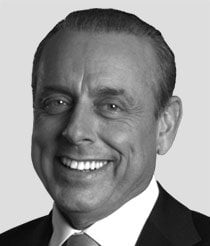It's yet another prime example of "The strong get more while the weak ones slave."
Private equity shops and institutional players are buying and packaging (securitizing) nonperforming mortgages from the Federal Housing Administration (FHA) and selling those mortgages to mutual funds and themselves.
On the surface, the U.S. Department of Housing and Urban Development (HUD) wants to minimize the cost to taxpayers. After all, we have to cover the insurance guarantees the FHA made on loans it backed but are now nonperforming or in foreclosure.
That's really nice of HUD and the FHA, thinking about us taxpayers. Maybe they should have thought about us when they agreed to guarantee payment on loans to less-than-prime borrowers who only have to put down 3% to get their loans.
But, whatever, they're from the government...
The FHA Is Here to "Help"
 It's also nice that most of those loans, the FHA-insured ones, get packaged into securities and sold to institutional investors. Because, you know, those institutional investors, the same ones who package FHA loans into securities and sell them to each other and keep piles for themselves, need us to cover their backsides.
It's also nice that most of those loans, the FHA-insured ones, get packaged into securities and sold to institutional investors. Because, you know, those institutional investors, the same ones who package FHA loans into securities and sell them to each other and keep piles for themselves, need us to cover their backsides.
It's just the socialization of losses to protect poor wee banks and financial institutions.
The FHA is looking to cut its losses on mortgages it guarantees, right at the time the housing market is supposedly strengthening. And so it's gotten HUD's blessing to sell billions of dollars of loans at $0.70 or $0.60 on the dollar (or less) to some of the same players that bought them in their original packaged form.
Why now? Why is the FHA selling nonperforming mortgages and mortgages on homes in foreclosure to institutional buyers just as the market has bounced and is supposedly strengthening?
Well, here's why all of this is happening right now.
It doesn't want to have to bear more losses on those loans. You get it? The market has bottomed, and now the FHA wants out as it's rebounding.
It doesn't matter that it's taking losses by selling loans at $0.60 on the dollar. It matters that there are buyers for them, buyers that are standing up to help taxpayers minimize their losses just as the market has rebounded.
So, these do-gooders are back to help us taxpayers out. Of course, these are the same do-gooders that bought up more than $100 billion of foreclosed homes to securitize and rent out. They bid up home prices so quickly that regular folks can't buy those homes at favorable prices... but now have to step up and pay the highest prices since the housing market implosion.
And the government is helping them help itself.
If you're wondering why these institutions would want to package these nonperforming loans they buy from the FHA, and why other investors would want to buy the new securities, you may have missed the fact that the U.S. Federal Reserve has a zero interest rate policy.
Because there's a massive yield hunt going on around the world, investors will take the risk of getting maybe a 4% return on these new securities, because it's a better yield than they can get elsewhere.
Are they stupid? No way.
The government is selling them these loans as the housing market has rebounded.
Here's what you maybe aren't getting. The government doesn't want to foreclose on these people. They're selling the loans to vulture squads that will foreclose in a New York second if they can reap a profit on the sale of the home after the loan principal is paid off.
Not that the folks at the FHA are that cruel, of course. They stipulate that the loan buyers can't foreclose for six months. After that, it's not their fault or their problem.
Now that home prices have risen, it might be a good time to kick out delinquent borrowers and sell the homes that back the securities.
Does it matter that banks aren't making mortgages hand over fist and there may not be a lot of buyers at pumped-up prices? No. The institutions aren't really going to sell those homes to you and me, you knucklehead.
They're going to sell those homes to themselves at favorable prices out of foreclosure. And then they'll rent them to you and me at the high prices we now have to pay.
And what will they do with those rental homes they own? They'll do exactly what they're doing now. They'll package them into securities and sell them to each other.
It's all about the institutionalization of the American Dream, with taxpayer backing of course.
More from Shah Gilani: The Alibaba IPO date could be as soon as mid-September, but everyone wants to know... should you buy Alibaba stock?Here's everything you need to know about the investing potential for this Chinese e-commerce megadeal...
About the Author
Shah Gilani boasts a financial pedigree unlike any other. He ran his first hedge fund in 1982 from his seat on the floor of the Chicago Board of Options Exchange. When options on the Standard & Poor's 100 began trading on March 11, 1983, Shah worked in "the pit" as a market maker.
The work he did laid the foundation for what would later become the VIX - to this day one of the most widely used indicators worldwide. After leaving Chicago to run the futures and options division of the British banking giant Lloyd's TSB, Shah moved up to Roosevelt & Cross Inc., an old-line New York boutique firm. There he originated and ran a packaged fixed-income trading desk, and established that company's "listed" and OTC trading desks.
Shah founded a second hedge fund in 1999, which he ran until 2003.
Shah's vast network of contacts includes the biggest players on Wall Street and in international finance. These contacts give him the real story - when others only get what the investment banks want them to see.
Today, as editor of Hyperdrive Portfolio, Shah presents his legion of subscribers with massive profit opportunities that result from paradigm shifts in the way we work, play, and live.
Shah is a frequent guest on CNBC, Forbes, and MarketWatch, and you can catch him every week on Fox Business's Varney & Co.



